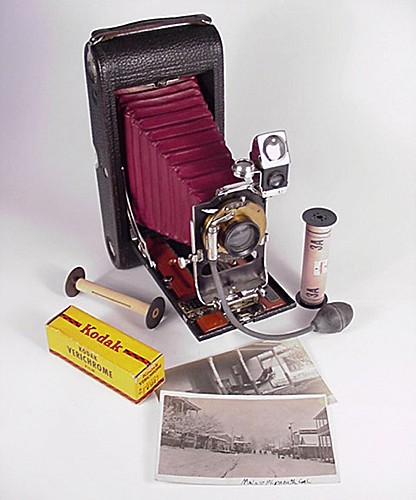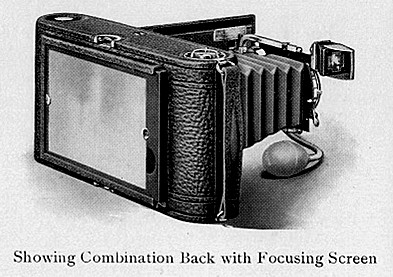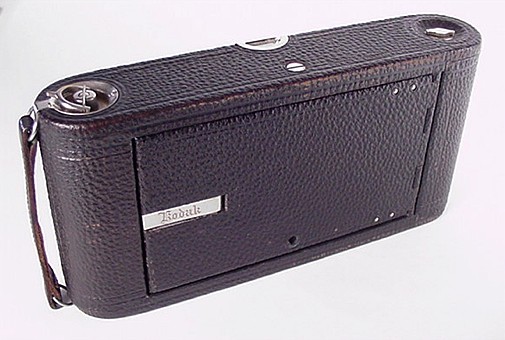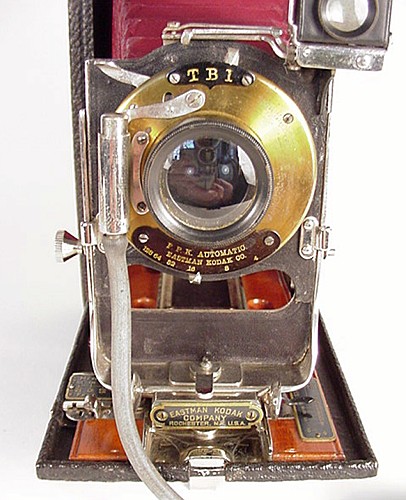
3A Folding Pocket Kodak Camera

The 3A Folding Pocket Kodak, Eastman Kodak's first postcard format camera was introduced in 1903 and sold until 1915. Kodak produced seven models of the 3A Folding Pocket Kodak (thankfully abbreviated as 3A FPK). The models were known as B, B-2, B-3, B-4, B-5, C and G. This example is a model B-2.
The image above shows a box of Kodak Verichrome Pan six exposure V122 film dated 1944, an exposed roll of 122 film on an all-metal spool and an early 122 film spool with wooden core. Later film spools were made entirely of metal, earlier spools of wood and metal.
The F.P.K. Automatic shutter was equipped with a pneumatic release. The original rubber hose and squeeze ball are still attached to the pneumatic cylinder. The shutter has one instantaneous speed plus time and bulb. The pneumatic release can prevent camera shake when using the time and bulb settings. The rubber hose and bulb are removable but because of their size they could also be left permanently attached, as they do not interfere with closing the camera.
The 3A FPK created 3 1/4 x 5 1/2 inch postcard format images on Kodak 122 roll film. Kodak 122 film was first introduced for use in the 3A FPK and was available in four, six or ten exposure lengths.

A glass plate adapter with ground glass focusing screen, available as an extra cost accessory, permitted the taking of photographs on glass plates. Eastman Kodak called this accessory the Combination Back. The above illustration of the Combination Back is from a 1912 Kodak catalog. The catalog price of the back is three dollars and fifty cents. Double plate holders were priced at one dollar each.

Closed, the 3A FPK measures 9 1/2 x 4 3/4 x 1 7/8 inches. Kodak advertised this camera as fitting neatly in an "ordinary top-coat pocket". Well, fashion is fickle. I think I'll just carry my camera around in its fitted leather case. Californians don't own top-coats, and none of my Levis have what you would call a roomy pocket.
When introduced, the 3A FPK, fitted with Kodak's top-of-the-line lens and shutter was priced as high as $78.00. Seventy eight 1903 dollars placed the 3A FPK in Kodak's top pricing tier. A variety of lens and shutter combinations were available for this camera. A 1912 Eastman Kodak catalog prices the 3A FPK with Kodak Ball Bearing shutter at $20.00, with Kodak Automatic shutter at $25.00 and with Compound shutter and Zeiss Kodak anastigmat lens at $61.40.
This is an attractive folding roll film camera with its heavy seal grain leather, state-of-the-art aluminum body, rich red bellows and wood accent. Yet, its features were fairly pedestrian with the exception of its novel format. I like postcard format photographs. Vertical shots tend to look a bit narrow, but when used horizontally, the somewhat panoramic effect is very pleasing. Postcard format is wider than the 24 x 36mm format of full-frame 35mm cameras. Can billions of postcards be wrong?
You can see an example of a vintage vertical format photographic postcard by following this link.

The F.P.K Automatic shutter has a manual release as well as the pneumatic release discussed earlier. This can be seen as the nickel-plated lever extending from the brass shutter housing, to the left of top center.
The lens on this example is a Bausch & Lomb Optical Company Rapid Rectilinear, with a 6 1/2 inch focal length, maximum aperture of US 4 and stops to US 128.
The waist-level viewfinder, partially visible at the upper right, is not bent at an angle. I must apologize for the barrel distortion I inflict upon my subjects when I set my digital camera to macro mode, and am forced to use the wide-angle lens setting. The camera is partly to blame, but so is my laziness and love of exaggerating features.
The waist-level viewfinder can be rotated 90 degrees so it can be used to take horizontal format photographs. The camera also has two tripod sockets allowing both vertical and horizontal time exposures.
An interesting detail of the 3A FPK, is the wood inserts on the camera bed. The inserts are strictly decorative, much like wood-trim automobile accents. Perhaps they were intended to gently wean the public from an age of wood-bodied cameras to the new material of the 20th century, aluminum. The camera is not made entirely of aluminum though, its sides are leather covered wood. Because some wood was used, the camera has a good heft which helps prevent camera shake. I find some all-aluminum folding cameras are too light.
The 3A FPK accepts an accessory glass plate back with ground glass viewing screen. The camera lens panel incorporates front rise and fall and horizontal shift for perspective control. These features require the use of the ground glass viewing screen.
The camera does not have a rangefinder. Focus can be set by viewing the image on the ground glass back, or when using roll film, it must be estimated. In this case, a pointer can be aligned with distances engraved in a focusing scale mounted on the bed.
The 3A FPK has a novel quick focusing aid. On the camera bed opposite the focusing scale is a metal slide that can be set to various distances. Once this slide is set and engaged, the camera front can be pulled along the track until it comes to a stop. The camera will now be focused at the preset distance. This would be handy if most photographs are taken at a regular distance.
If you would like to see a vintage Seneca No. 9 wood-bodied glass plate postcard camera manufactured by the Seneca Camera Company, follow this link.

|
Page created March 12, 2002; updated December 20, 2020
|